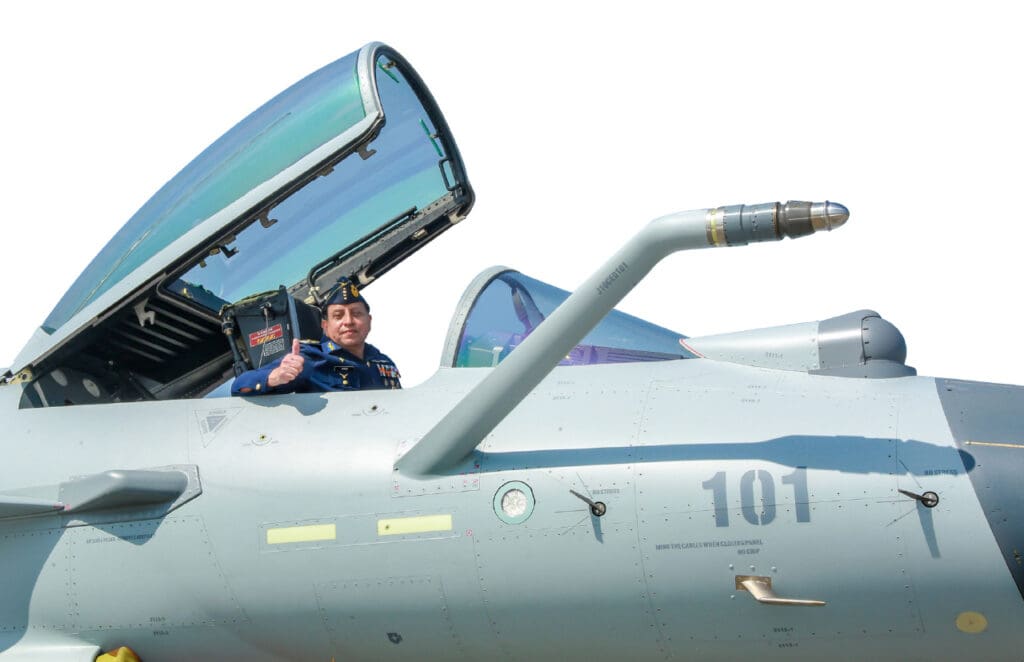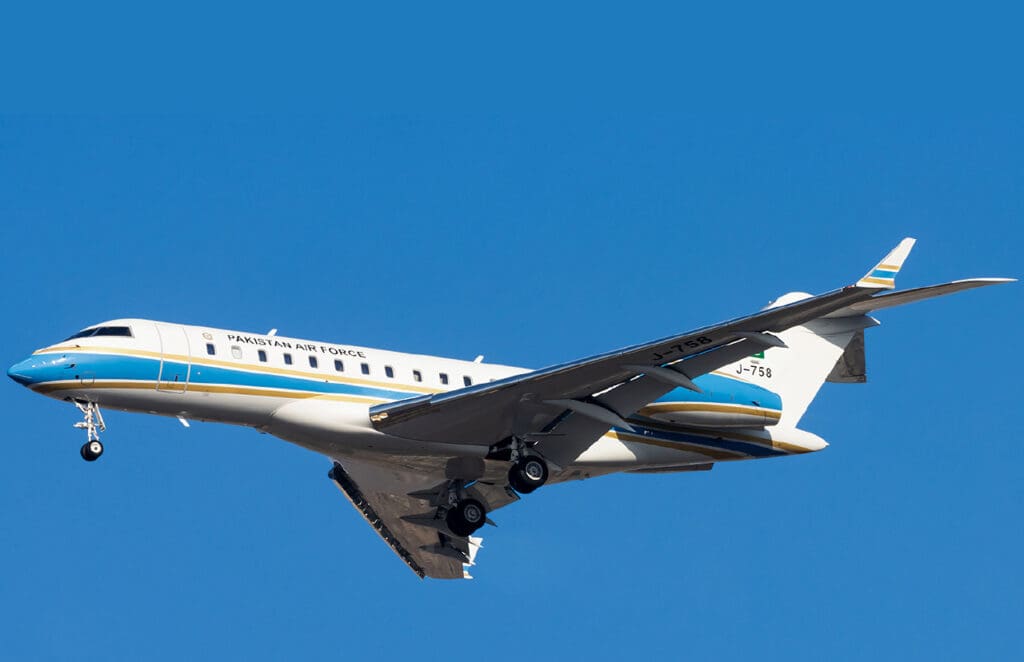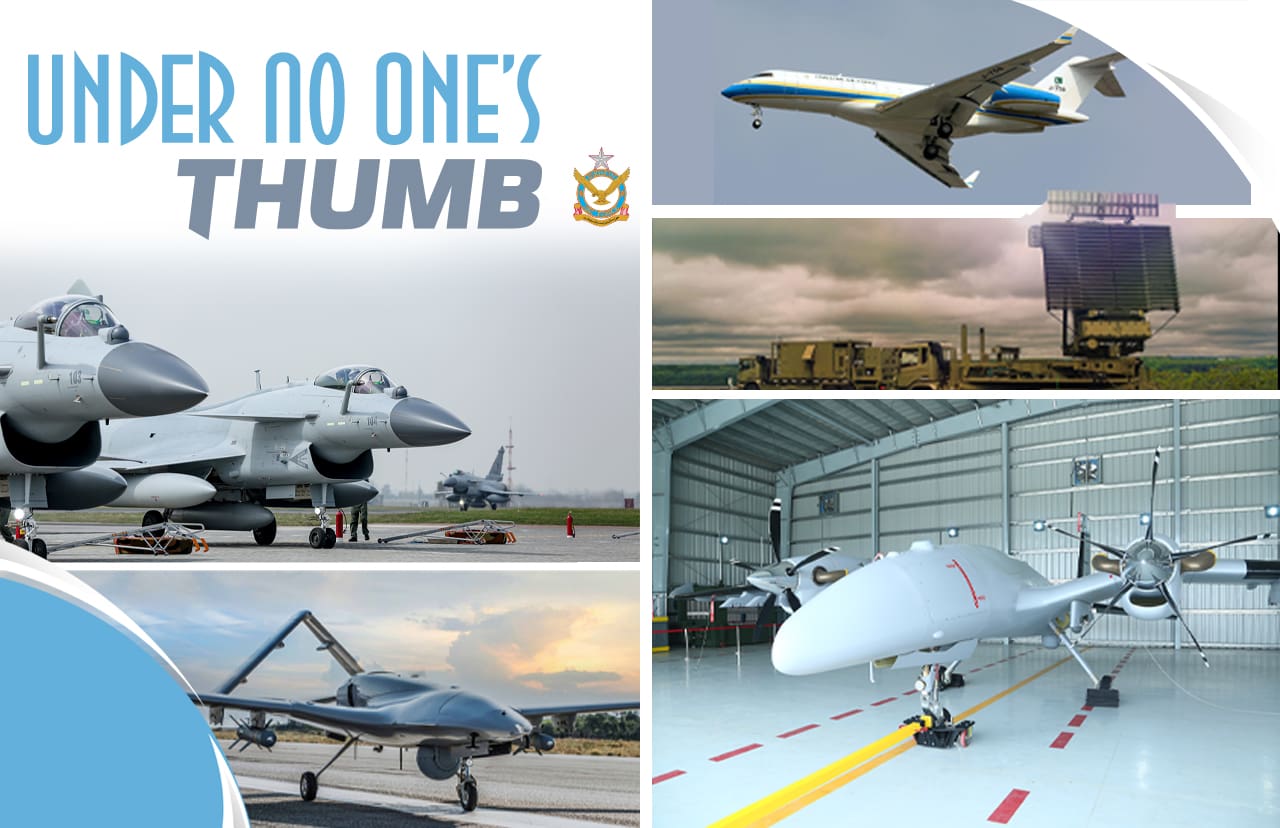When the PAF started out it had little more than some mainly obsolete planes and fewer airmen than its belligerent neighbour. How on earth could they go toe-to-toe with any other bigger power? Flash forward some 70 years, with the latest Thunders and Dragons in its inventory besides the fleets of unmanned aerial systems, fresh induction of transport aircraft, long range missile defence systems to mention some of the newest acquisitions, of course things have changed dramatically. Today the PAF is a mighty force to reckon with. But how did they get here?
Recent conflicts has demonstrated that the character of war had changed rapidly. Devastating effects on conventional forces through drone applications, electronic and cyber capabilities, augmentations by AI application had been well established in recent Azerbaijan-Armenia and Ukraine–Russia wars. Under the current evolving character of warfare, PAF felt the need to take stock of its operational capabilities. Staying fully cognizant of the situation, the CAS tasked all branches to undertake a capability gap analysis in 2021. After identifying critical deficiency areas in all domains and after sorting out a carefully crafted financial plan under constrained fiscal space, he gave his vision of smart and cutting-edge Inductions to fill capability gaps in all vital domains. The induction plan comprised following cardinals, such as the acquisition of only high-end technology, so that it could effectively serve PAF for at least the next decade and a half. It also included timely inductions, to quickly mitigate operational deficiency, low operating and life cycle support cost and lastly, downloading of technology to support indigenous production.

“As far as the evolution of military technologies is concerned, our 20th Century experience was not ideal. Policies based on exceptionalism have affected the international process of sharing of knowledge and technologies, integration of defence industries and global supply chain and the access to advanced weapons systems. This myopic approach has negatively affected regional stability and has led to dangerous, irresponsible and provocative strategic behaviour, particularly in South Asia,” the Air Chief maintained.
He has argued that Lethal Autonomous Weapons Systems such as UCAVs and Loitering Munitions, along with hypersonic missiles and space militarization had transformational effects on the nature, character, complexity and speed of warfare, adding, “This in turn significantly affects strategic decision-making system and process, battle-space and information management and the entire philosophy of military training and leadership.”
Air Chief Marshal Zaheer Ahmed Baber Sidhu, NI(M) maintained that these technological advancements has forced a critical review of traditional strategic thought and major paradigms of defence and strategic studies and led to the evolution of new concepts in strategic affairs such as Smart Power, Sharp Power, Hybrid warfare, Grey Zone and Non-Contact Warfare.
All Branches of PAF had worked in close coordination to efficiently materialize the induction plan through a two-prong strategy i.e. high-end technology procurements from foreign sources and inductions from local industry to fully support indigenization and self-reliance as per the guidelines of Worthy CAS vision.
During FY 2021-22 and FY 22-23, an unprecedented number of high value systems had been contracted, which would augment PAF’s warfighting potential manifold. Several of these systems had been successfully operationalized already, whereas few were scheduled to be delivered within the current calendar year.
Under the command of the current Chief of Pakistan Air Force Air Chief Marshal Zaheer Ahmed Baber Sidhu, NI(M) Pakistan Air Force has come a long way, making its presence felt across the top end. Under his resolve, the PAF high command endeavoured to become more enterprising and dynamic, considered unstoppable, acting with precision, speed and communication, taking the enemy by surprise. All this had been the consequence of sound planning and some luck.

Speaking at the GSTAR 2022 event, CAS, PAF, Air Chief Marshal Zaheer Ahmad Baber said, “The safety, dignity and prosperity of our nation in all its manifestations are the ultimate purpose of Pakistan’s national security. Pakistan Air Force is making an omni-role, substantive and lasting contribution towards all these important national security objectives.”
Since being in office, his team had critically analysed the challenges, identified the deficiencies and embarked upon prompt action to bridge the gaps in short term alongside clearly defined objectives for transitioning PAF into Next Gen Air Force. “Virtually no area has remained untouched,” Zaheer Ahmed Baber Sidhu (NI(M) assured his countrymen.
However, it has not been an easy journey. In these times of financial crisis and foreign currency scarcity, the Air Chief was faced with a new set of challenges. All kinds of procurements were only possible through effective management of the Operational & Maintenance (O&M) expenditure. An extensive fat from operations was removed through microscopic scrutiny and curtailment without losing the combat prowess. Systems with high O&M costs were retired and operations were enhanced on the platforms with low O&M costs. Force augmentation efforts were used to increase the effects of the same sorties without increasing operating costs significantly. It was a true demonstration of an out of the box approach in crucial situations. A strange fact was that, last two years, probably, were financially the most troubled year for PAF in its history. Nonetheless, the last two years witnessed the most acquisitions by PAF as the air boss decided to turn things around, setting a tone for a far advanced air force.
J-10CE

Following restrictions by the US on American weapons platforms to Pakistan, the PAF became unable to obtain the type of advanced jets such as the notorious F-16. The air force had turned to creating highly advanced fighters themselves such as the JF-17 Thunder and aimed to acquire higher performance fighters with the assistance of the Chinese. It was in these discussions that the J-10 had its origins. The aircraft is equipped with latest avionics / EW suite and state of the art AESA radar complemented by PL-15 BVRAAM. Moreover, operationalization of PL-10E high off-bore IIR missile with IRSTS & HMD combination has opened a new paradigm for PAF in terms to WVR air to air combat. Like any modern aircraft it also has an Encrypted secure data link. The capability list of the aircraft is endless and sensitive in nature too. J-10C along with its latest avionic suit and PL-15 long-range BVR has restored the balance in favour of PAF again which was lost due to Rafael & Meteor combination. With this one quick procurement , IAF’s dream of gaining qualitative superiority was neutralized before it saw the light of the day.
“The impact of emerging technologies is profound in terms of nature, global in terms of scale and strategic in terms of effects. It simultaneously influences the political, social, cultural, economic and military domains. This has created new challenges for the traditional military structures, cultures, services and processes at all levels,” the Air Chief aptly said adding, “The advent and advancement of new technologies such as Artificial Intelligence and Machine Learning are now affecting almost all aspects of human life and global environment.”
In the last two years, the PAF had come up from some place to first place in the region. This was the task achieved by the will and energy of the entire force. Endeavouring to develop a new way of war, the PAF embarked on utilizing fully digital and advanced technologies. Inducting drones was the answer to navigate emerging complex challenges and shoot at the enemy from a long way away.
The Scourge: TB2 UAS

Drones had been the missing pieces in PAF’s strategy to boost its strength. Pictures of modern wars were significantly different from what we are used to seeing in historical movies and documentaries. Massive infantry attacks under the shelter of tanks and artillery are still necessary for military operations. However, most modern forces are trying to use weapons systems that can be controlled remotely and cause maximum damage to the enemy without endangering people’s lives. One example of such a weapon is the frightening TB2 UAS.
This is a reconnaissance combat drone and can be used for spying and for destroying specific targets. As recent times saw a resurgence of terrorist activities in the countries after a lull of about five years, to counter the resurging threat PAF was required to provide persistent ISR and CT capability in the troubled areas. Providing the effort of manned systems similar to what was done in Ops Zarb e Azb was cost prohibitive given the fiscal challenges faced by the PAF. Consequently, swift procurement of battle tested TB2 UAS was initiated. In record time the UAS were flying in Pakistani skies. These along with other UAS systems provided a cost-effective way of creating the required effects in the CT domain.
Akinci UAS
For persistent presence in the battle field for ISR and ES, PAF historically relied on the manned platforms like DA-20, RT-33, RB-57s etc. However, these systems had limited persistence while being vulnerable. Due to the lack of targeting capabilities, they did not reduce the sensor-shooter chain. With the capabilities to wreak havoc with pinpoint accuracy, the procurement of the Akinci MALE UAS system filled this gap for PAF. A real warrior in the sky, with outstanding artificial intelligence technology, robust, agile and combat ready, the ISR capability ranged from Long range SAR, multi-band ES and HD EO/IR payload coupled with long range weapon capability and long endurance. The Akinci UAS provided PAF a faster OODA at the eastern border as well as in the CT campaign.
Air Mobility Platforms
Maintaining a dependable AM fleet was extremely crucial for the desired force agility of PAF in light of the threat of long range SOWs. With the ageing C-130 fleet, PAF was reaching a critical state. Therefore, preservation of the existing fleet and procurement of additional aircraft became essential. Additional C-130 H were procured from the Belgian Air Force to augment the fleet. In order to preserve this crucial air lift capability, some low-cost aircraft were procured to reduce short haul and passenger movement. Aircraft like AB-319, Bki-350 and M-600 Piper aircraft with their extremely low operations and maintenance (O&M) cost took off a lot of burden from the PAF’s C-130 fleet while reducing the overall O&M budget. In addition, AB-319 also provided a capability of long-range Air Ambulance for international HADR situations. The platform immediately after induction became handy in the evacuation of Pakistanis stranded in Sudan.

Beechcraft King Air 350i
In the occupancy logistical category, PAF’s ageing Y-12 and expensive to operate CASA fleet warranted replacement with suitable modern yet lowest operating cost platforms having capability to operate in length and breadth of Pakistan including Northern areas. Trying to build in a short time what would defend the nation, Beechcraft King Air 350i was selected. This high performance low operating cost aircraft suited such operations. These aircraft were equipped with a glass cockpit fitted with Proline Fusion Avionics and could fly at an altitude of 35,000 feet and up to a range of over 1,800 NM. All trainings had been concluded and aircraft were fully operational in PAF.
Piper M-600
To offset low occupancy air mobility requirements, Piper M-600 were contracted. The aircraft had high-performance parameters and possessed one of the lowest operating costs. It was also equipped with a glass cockpit and the latest Garmin-3000 avionics package. All aircraft were inducted into operations. The timing of these upgrades had been timely at the very least.
Phenom-100
PAF has been operating a highly popular and commercially successful aircraft, Embraer’s Phenom 100 since long. However, in early 2021, additional Phenom 100 aircraft were added to the fleet at an extremely low cost. The aircraft augmented the existing fleet of PAF’s light communication aircraft as it became a unit of air mobility in the PAF.
Bombardier Global – 6000
Everything envisioned materially has increased PAF capabilities significantly enhancing deterrence to a belligerent neighbour. Induction of SOJ platforms was a long standing PAF force goals requirement. In this regard, cooperation with Turkish Aerospace Industries’ was being pursued. For this purpose, a pre-owned Bombardier Global – 6000, had been acquired and is currently fully operational carrying out air mobility operations. In near future, the platform would be inducted for EW Suite retrofit in Turkey.
Airbus A-319
To cater for extended range variable load carriage capability requirements of PAF, an Airbus A-319 aircraft had also been acquired. The platform is capable of conducting operations in combi-configuration for EMS, passengers, cargo missions, and also has prospects of future employment in advanced roles. AirBus 319 offered global reach stretching up to Far Eastern, European and South African countries at highly reduced operational cost. The aircraft had arrived and was operational in PAF inventory. Additionally, medevac modification on the aircraft was also underway. After completion the aircraft would be available for swift medevac service not just to PAF but to any agency as per requirements of Government of Pakistan.
Boeing 737
In addition to the acquisition of the Airbus for PAF, Shaheen foundation had recently inducted its first Boeing 737 freighter for undertaking commercial operations in a bid to build its own cargo fleet subsequently.
The acquisitions of military enhancements were just the latest pieces of a revival and renewal of commitment to aerial supremacy. These were real achievements, a sign that the contest for influence was not going all India’s way. Missiles were also at the centre of the plan.
HQ-9B HiMAD
Considered to enhance the country’s air defence network, Pakistan required a long range missile system that could intercept various threats such as air to ground missiles, helicopters and aircraft, UAVs, beyond visual range (BVR) missiles and guided bombs besides other tactical missiles. This was necessary to create an effective A2AD environment in our skies and to maintain Air Superiority in the DCA role. The HiMAD became essential, Pakistan’s first long range surface to air capability. Its persistence and range provided extraordinary flexibility to the air commander. While these systems were not alternative to manned aircraft doing DCA, however, they effectively complement the role. Hence, the first battery of HQ-9B from China was ordered and was likely to be delivered soon. Contracts for additional batteries are in progress. These systems were nearly as effective as the famous S-400 systems.
EADS
In today’s increasingly modern and complex warfare, with multiple threats and arenas, sophisticated weapons and sensors have become critical acquisitions, enhancing essential capabilities for the multi-dimensional battlefield. Long range weapons and BVRs are highly dependent upon the electronic sensors. An intelligent way to neutralize these is to disrupt these Electronic Sensors thus hampering the Sensor-Shooter chain or the weapon guidance itself through Electronic Attack. In the same context PAF procured Electronic Air Defense Systems from China providing persistent ES as well as EA capability in the desired AoR. This capability ensures battlefield domination and mission success by overwhelming the enemy’s sensors and presenting the enemy with the wrong target.
The scale and significance of the new acquisitions and the response by the PAF showed its strength and determination to keep the skies above Pakistan impenetrable. The PAF made immediate and major investment in advanced radars as it realigned its defence needs to deal with the rising challenging strategic circumstances.
Radars
They called radars an airplane’s worst enemy. Long range jam resistant multi-role radars are an important operational requirement in these times of an electronically intense battlefield. Now classic low level or high level radars may not be cost effective and may not provide the required dividends. Therefore, YLC-18 and TPS-77 MRR were procured to overhaul the vintage Air Defense system of PAF. After PADS 77 in 1977, this was the largest rehab of the PAFs Air Defense system. In order to detect low observable platforms like small UAVs and stealth aircraft Chinese YLS-8E radars were contracted and were likely to be delivered soon.

Air Defence
The Air Defence domain had been another important focus of the CAS. In contemporary warfare, strong air defense with availability of Anti Access area denial (A2AD) weapons could effectively deter an enemy’s offensive. However, during critical gap analysis, this area was severely found wanting. Therefore, CAS declared it as a special focus area two years ago. After colossal efforts by all stakeholders, PAF filled this gap.
YLC-8E
Low observable stealthy platforms and hypersonic missiles posed a serious threat to aerial defence. Thus, acquisition of modern radars with Brahmos class stealth detection capability became an operational priority for PAF. A number of options were evaluated and year-long in-country trials were carried out of two Chinese origin radars. After a thorough evaluation process, the YLC-8E Mobile Radar System with integration into PAF AD Network, related trainings and assured spares support had been contracted.
TPS 77 MRR
The acquisition of TPS77 MRR, was a serious signal that Pakistan was sombre about its security. To augment the existing coverage in Low / medium level Air Defence Ground Environment, different options were explored and US made TPS -77 MRR was selected for induction in PAF. TPS-77 MRR is a state-of-the-art radar with Active Phased Array Technology, software designed architecture, capability to detect TBM and enhanced ECCM capability. All radars had been delivered, deployed, operational and integrated within the PAF network successfully.
TPS 43G
In order to ensure seamless coverage in the high-level regime, contracts for upgrade and life extension of legacy TPS-43G radars were signed with US based original equipment manufacturer (OEM). After the upgrade, performance of these radars had been restored to original parameters along with enhanced ECCM features.
The threat may not be of invasion but of major conflicts that threatened Pakistan’s national interests. That included everything from instability on the eastern border with India, to incursions into Pakistan’s economic interests along the western borders with Afghanistan.
The enemy was no longer the uncontested leader in the region. There was no scaling back on enhancing military capabilities. Security in the region remained critical as ever to Pakistan. The air force was getting that balance right. PAF’s commitment to defend the nation was iron clad.








